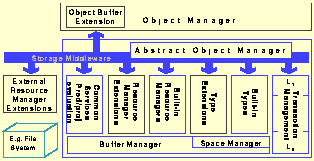An Open Abstract-Object Storage System
CONCERT is a long-term prototype development effort designed as a vehicle for our research activities in open storage management. CONCERT demonstrates key open features, including the ability to apply database functionality to externally-stored, externally-defined data. CONCERT is the development environment for a number of projects including HERMES on multimedia information systems, on image databases, and on raster data management in database systems. The Figure illustrates CONCERT's internal architecture.

CONCERT is a long-term prototype development effort designed as a vehicle for our research activities in open storage management. CONCERT demonstrates key open features, including the ability to apply database functionality to externally-stored, externally-defined data. CONCERT is the development environment for a number of projects including HERMES on multimedia information systems, on image databases, and on raster data management in database systems. The Figure illustrates CONCERT's internal architecture.
CONCERT is founded on an Abstract-Object Storage Model. This provides mechanisms whereby new implementations of the known CONCERT basic types can be embedded within the system, and hence existing database functionality applied to external objects. For example, a standard basic type construction for database systems is a record. CONCERT admits new implementations of record types through new implementations of the basic record operations: project and compose. Such openness features extend to all CONCERT types; these are: UNKNOWN, SCALAR, RECORD, LIST and CONTINUUM.
Of the key types above, CONTINUUM is somewhat novel. This is a single abstraction supporting spatially-extended data: temporal data, 2D spatial data, or video and audio streams. The key operations over continua are: cut, compose, bounding-box, intersects and, contains. These operations suffice for many important spatial data-management tasks.
Resource extensions are resource managers providing characteristic access-path or resource-management functionality; examples are B-tree and raster-data manager. CONCERT provides basic mechanisms for the incorporation of new, externally-defined resource extensions. A novel aspect of CONCERT in this respect is the use of resource extensions as object buffers providing application-area specific mechanisms for transferring data between the CONCERT kernel and CONCERT clients.
As the fundamental unit of operation is the external operation, special mechanisms are required to support the use of these. One such mechanisms is the memory-mapped buffer manager which provides uniform addressability over long objects directly within a shared database buffer. A further mechanism specific to the use of externally-defined operations are the bookkeeping mechanisms CONCERT provides for keeping track of resource usage while admitting both deep and shallow copying of objects, according to processing requirements.
An example application which we have developed is that of Geospatial Metadata Management. Geospatial metadata is data about geospatial data; for example, where, when and how a satellite image was acquired. We have developed a geospatial metadata extension to CONCERT which demonstrates the use of indexes over (complex) external data, and the processing of database queries over that external data. However, the primary repository remains the external repository. Hence an advantage of our approach is that existing applications, scripts and browsers can be retained, thereby admitting smooth migration to database solutions.
References
Stephen Blott and Lukas Relly and Hans-Joerg Schek, An Open Abstract-Object Storage System. In: Proceedings of the 1996 ACM SIGMOD Conference on Management of Data, Montreal, Canada, June 1996.
Stephen Blott, Helmut Kaufmann, Lukas Relly, and Hans-Jörg Schek, Buffering Long Externally-Defined Objects. In: Proceedings of the 6th Int. Workshop on Persistent Object Systems (POS6), Tarascon, France, September 1994.
Lukas Relly and Hans-J. Schek and Olof Henricsson and Stephan Nebiker, Physical Database Design for Raster Images in Concert. In: 5th International Symposium on Spatial Databases (SSD'97), Berlin, Germany, July 1997.
Lukas Relly and Heiko Schuldt and Hans-J. Schek, Exporting Database Functionality - The Concert Way. In: IEEE Data Engineering Bulletin, special issue on Interoperability, 1998.
Alexander Kuckelberg, Lukas Relly, Hans-J. Schek, A Framework of a Generic Index for Spatio-Temporal Data in Concert. In Workshop on Spatio-Temporal Database Management (STDBM 99), Edinburgh, Scotland, September 1999.
Lukas Relly and Uwe Röhm, Plug and Play: Interoperability in Concert. In: A. Vckovski et al. (Eds.), Interoperating Geographic Information Systems, Proceedings of the 2nd International Conference, INTEROP'99, pages 277-291, Zurich, Switzerland, March 10-12, 1999.